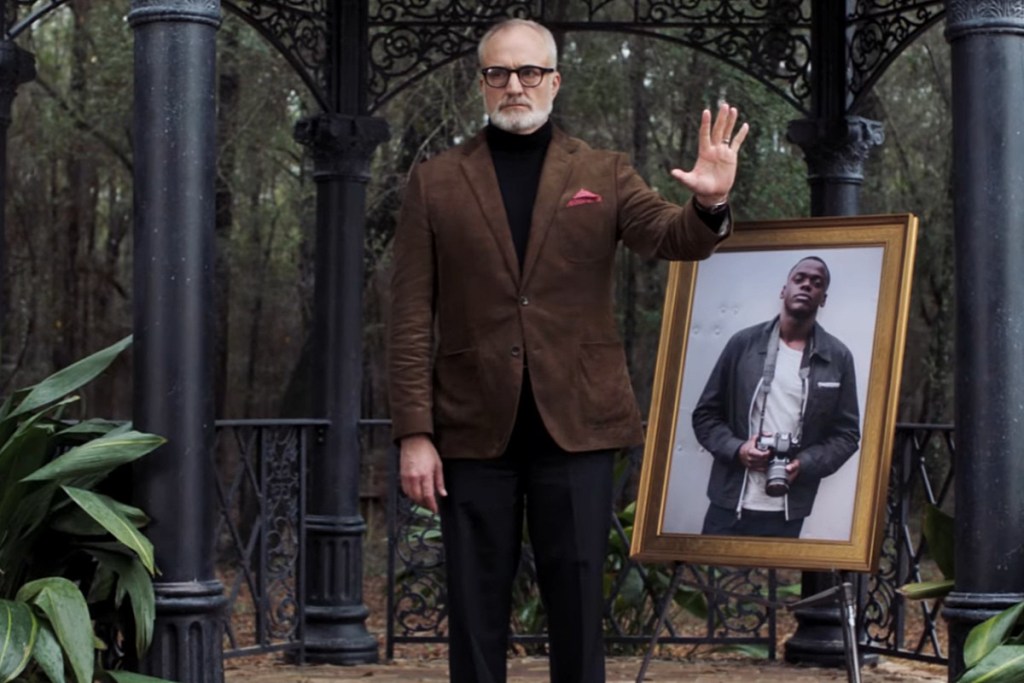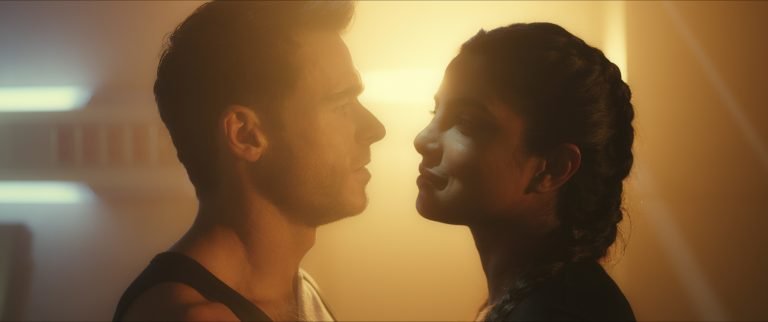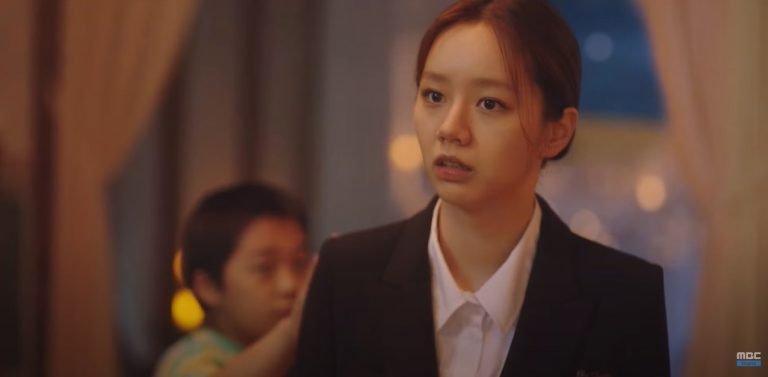Get Out (2017) Movie Ending, Explained: Get Out is Jordan Peele’s directorial debut film, which won an Oscar Statue for ‘Best Original Screenplay’ in 2018. Jordan Peele showed his abilities in the writing of a thriller-horror movie and also making a low-budget movie. In fact, Get Out can be studied for its many “How To”s of film-making. For instance, how to make a multi-genre movie and gradually move its focus on the primary genre (here, thriller genre). Get Out starts as a hybrid of romance and a possible road-movie and becomes a horror movie gradually, and finally meets the conditions of being a crime/thriller flick.
The film starts with a scene of a young African American man (LaKeith Stanfield) talking on his mobile phone. Suddenly, he is ambushed by a stranger and pushed into a car. Keeping up with the tradition of thriller movies, the film starts with a suspenseful sequence that raises a big question in audiences’ minds about what will happen to the kidnapped man. However, the film leaves us without solving this hazy situation and moves on to present the story of the main characters after the opening credits.
Get Out (2017) Plot Synopsis & Analysis:
A Romance and Road Movie Transforms into a Thriller Narrative
Chris (Daniel Kaluuya) is a young black man who plans to travel with his white girlfriend, Rose (Allison Williams), to spend the holiday with Rose’s well-to-do family. Chris has doubts about going there. He feels discomfort over the fact that he is a white girl’s black boyfriend. Rose tries her best to make him feel comfortable, and it seems she doesn’t want to leave him alone within her family’s weird and intimidating realm.
When Chris faces the Armitage family, they look like a close-knit family, but there are strange things about the servants, who are all African American. Rose’s father, Dean Armitage (Bradley Whitford), is a personable neurosurgeon, and Rose’s mother, Missy Armitage (Catherine Keener), is a psychotherapist who is skilled at using hypnosis. In a way, the combination of a body and mind expert remains a foreboding element.
A Travel to the Depth of Chris’ Mind
Get Out (2017) starts like a road movie. Like a typical road movie, it’s also centered around the main character, Chris’s inner psychological journey. He is exploring his white girlfriend’s sophisticated world, besides the trip on the road, during which Rose hits a deer (sacrificing a gentle, innocent creature). These two journeys are mixed and will be expanded afterward by Missy Armitage, who, as a psychotherapist, guides Chris to the depth of his mind and deceptively creates a trap within himself.
This method and all the strangeness surrounding Chris works like the trope of a “Femme Fatale” in film noirs where a flawed male character comes to terms with the horror of his surroundings. Femme Fatale always guides a man, especially an arrogant man, to be used by the social life controllers as a player in their game. She uses the man to achieve the goal, and then the game is over. But No, it is not that simple! Because the woman sometimes also falls in love with the vulnerable version of the man, and she has the dilemma of choosing between her task (mission) and her love.
Double Indemnity (1944) by Billy Wilder and Notorious (1946) by Alfred Hitchcock are the best examples of this pattern for the female character (femme fatale). Barbara Stanwyck in Double Indemnity and Ingrid Bergman in Notorious are Femme Fatales who have a mission to seduce and direct the male character. Still, both of the women fall in love with the man, and the game becomes complicated.
But in Get Out (2017), we have Rose as a femme fatale without the ability to love. This perhaps makes a monster out of her, and it is a sharp point of characterization in this movie. Rose seems like a femme fatale, but she is not because she doesn’t have the emotional abilities that can guide her to the dilemma that human beings would experience. So, a massive change in one of the most loved film genres occurs here: A femme fatale without the difficulty of having to choose between their task and love causes us to focus on the main character, Chris, and the complex interplay surrounding him.
Get Out (2017) ENDING, EXPLAINED:
Did Chris Overcome His Childhood Trauma?
Chris magically loosens himself and escapes from the brainwashing room. We can remember many horror-thriller movies in an old mansion, where the victim tries to escape from the second floor, goes down the stairs, and faces the owners of the house, and the game begins. Before the last sequence, we have the cliché fighting of Chris going against Missy Armitage and the revived brother Jeremy (Caleb Landry Jones) to get out of hell. The tension and suspense rise due to the crosscutting between Chris’ situation and Rose in her room listening to music with headphones. This situation continues to make a hero out of the main character, Chris. At a critical moment, the antagonist, Rose, suddenly realizes something is happening downstairs and emerges with a big gun.
After Chris manages to get out of the house and into the car, he hits Georgina (Betty Gabriel), and she falls on the ground. After hitting a deer on the road in one of the first scenes, this is the second time Chris has had a chance to encounter his childhood trauma. The trauma came into existence when Chris, in his childhood, was scared to do something about his mother’s dying situation because he thought taking the situation seriously and doing something about it would make his worst fears turn into a reality. In fact, Chris’ horrific journey in the narrative tells us, “Whatever you are scared of, will happen to you.” So, at this moment in Chris’ life, he must choose between doing something for a dying person, which can threaten his life, or he should escape from the situation.
Finally, by saving the dying Georgina, Chris overcomes his fear and is somewhat liberated mentally, but the game is not over yet! This situation is like Hitchcock’s Vertigo, where in the final scene, John (James Stewart) finally can go up the stairs and overcome his Acrophobia. But similar to “Get Out,” that particular moment of overcoming fear and trauma is not the end.
When Rose, armed with a gun, sees Chris putting Georgina’s body in the car, she says, “Grandma.” Soon, we realize that Georgina is Rose’s grandmother, i.e., the young black woman is merely the host of Rose’s grandma. Then, Rose calls her grandpa to save the grandma, and we see a stitched line on Walter’s (Marcus Henderson) face. When Walter starts to run fast, we can recall the moment we were surprised by seeing how Walter runs so fast at night.
How The Armitage Family Uses The Abilities of Black People to Always Stay On Top?
Jordan Peele calculatingly builds the script to let an attentive audience get the message of his film. We can conclude that the game that the Armitage family is involved in was not to use the sexual abilities of black people like Rod Williams’ (Lil Rey Howery) assumption. But it was to use the physical abilities of black lives to avoid being old like grandma and to avert disabilities like the paralyzed Jim Hudson (Stephen Root). We realize it sooner than the protagonist realizes it, and it brings more attention to the film’s ending to know when and how the character will recognize this vital information. It reminds us of the narrative methods used in Hitchcock’s movies to make the audiences know more than the protagonist, which gives us all the more reason to invest ourselves in the narrative.

Hitchcock describes the most effective suspenseful element in movies is when you reveal certain information only to the audience. For instance, in a story, a filmmaker can place a bomb under a table and then allow the two people around the table to have a long conversation. The audience will closely focus on the moment and will be interested in knowing whether the characters overcome or succumb to the threat hanging over their life. In a similar fashion, we follow Chris to see whether he comprehends the many dangers surrounding him, and we wonder what he’ll do about it.
Despite all the terrible things Chris experienced because of Rose, he spares her life eventually, simply because he is not a killer. He spilled blood only out of his basic instincts to survive. Anyway, Walter (her former lover) has already shot Rose, and she is dying. Soon, a cop car arrives, and naturally, Rose calls for help, and Chris, the black man, raises his hands. But just when we think the situation doesn’t look too good for Chris, we see that it’s his friend Rod who has traced Chris’ phone to the location. It’s also not a cop car but a vehicle from Rod’s job as TSA at the airport. Perhaps the flashing blue and red lights made us assume the worst and that Rose’s manipulation would eventually save her. But Chris survives and remains at large.
The Final Destination
Get Out (2017) starts with a black man casually walking on the street and getting captured. Now, after the movie ends, we realize the horror you live with just because of your skin color. Ultimately, the film tells us how stereotypes persist in our society and how there’s always a sinister conspiracy in the form of racism. Get Out is about the continuing racial discrimination of black people and how the allegedly progressive-minded use science, especially neurosurgery, psychoanalysis, or some other bullsh*t, to figuratively or literally possess black bodies for their benefit. Despite all the candy-coated liberalism, white America probably wants to send the colored peoples’ consciousness to the “sunken space” and only adapt their physical abilities.
Jordan Peele seemed to be telling us that a semblance of political correctness isn’t simply going to change the deep-rooted problems of racial discrimination. The satire and horror gracefully come together to unmask the ugly face of a seemingly liberal White community.





![Kaun Banegi Shikharwati [2022] Zee5 Review: A massive misfire of a Series that bores to death](https://79468c92.delivery.rocketcdn.me/wp-content/uploads/2022/01/Kaun-Banegi-Shikharwati-768x403.jpg)
